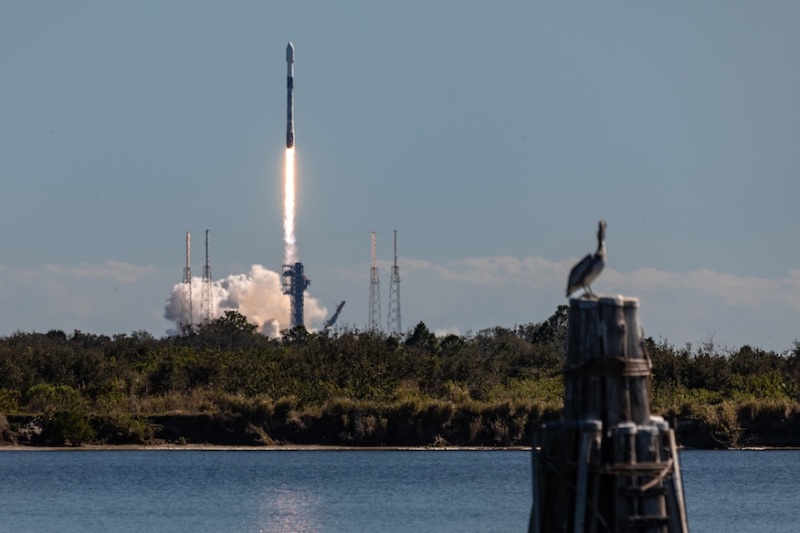This month, SpaceX successfully completed its second mission to the International Space Station. But this journey didn’t include a Dragon spacecraft, in contrast to all other missions that were aimed toward the orbiting base.
As part of NG’s 20th Commercial Resupply Services (CRS) contract mission for NASA, SpaceX launched a Cygnus spacecraft on behalf of Northrop Grumman utilizing its Falcon 9 rocket at 12:07 p.m. EST (1707 UTC).
With a bright blue sky serving as the backdrop, the rocket took off from Space Launch Complex 40 (SLC-40) at Cape Canaveral Space Force Station (CCSFS).
This mission’s primary Falcon 9 first stage booster, tail number B1077, completed its tenth flight. It has already launched four Starlink flights, the SpaceX CRS-28 mission, and the Dragon Endurance for the Crew-5 voyage.
After a little more than eight minutes of flight, B1077 landed at CCSFS’s Landing Zone 1. As the booster is reentering the atmosphere during the landing, viewers from Florida’s Space Coast or other portions of Central Florida would have heard a sonic boom.
This will be the 269th Falcon 9 booster landing to date, the 35th booster landing at LZ-1, and the 44th land touchdown for SpaceX in Florida.
Numerous firsts
For all parties concerned, the NG-20 mission launch represented a number of significant turning points. As was previously reported, this was the first time a Cygnus spacecraft for Northrop Grumman was launched by a SpaceX Falcon 9 rocket.
Bill Gerstenmaier, vice president of Build and Flight Reliability at SpaceX, spoke about the first of three intended missions for NG during a prelaunch conference with reporters.
“It’s a tremendous honor to be part of this team. It’s a neat effort to see how all the spaceflight participants come together,” Gerstenmaier said.
According to Gerstenmaier, SpaceX modified the payload fairings of the Falcon 9 to enable cargo to be loaded at a fairly last-minute, as the Cygnus spacecraft must be reachable.
A door measuring five feet in length and four feet in width is part of these fairings, he claimed, and it’s “more than just a hatch.”
“It’s actually an environmentally controlled area, so we don’t bring any type of debris or contamination in,” he explained. “The front part of Cygnus is very sensitive, as it berths the station. There are some rings that seal it to the space station. We cannot contaminate those rings. We have to make sure the cargo is delivered safely through this door, into the fairing and then carefully placed inside Cygnus for launch.”
According to him, the door is situated close to the payload fairings’ bottom. He claimed that on Monday night, a truck backed up to the fairings and a platform that allowed personnel to access the entrance was mounted to the exterior of the fairing.
“We at SpaceX like to do innovative and creative things. So, you can give us the challenge and tell us you need us to cut a five-foot by four-foot hole on the fairing and we figure out a way to go do that,” Gerstenmaier said. “The fairing is still recoverable, just as they were before.”
According to Northrop Grumman’s vice president and general manager of tactical space systems, Cyrus Dhalla, the Cygnus spacecraft didn’t need to be modified in preparation for this trip. To make room for their new voyage to space, they did modify their loading processes.
Russia’s invasion of Ukraine is the reason Cygnus requires the Falcon 9 to launch it to the International Space Station. The Antares 230+ rocket was retired due to a combination of the conflict and the gradual withdrawal of Russian-made engines.
In collaboration with Firefly Aerospace, NG is developing the Antares 330, their next launch vehicle, however it won’t be ready for use until at least 2025.
Additionally, this was the first Cygnus spacecraft launch from the Cape since 2017. United Launch Alliance’s Atlas 5 rocket was used for the last three of these missions, which included CRS Flight 7.
fresh freight and scientific
More than 8,200 pounds of supplies and science for the ISS crew members who live and work there are carried on the Cygnus. A surgical robot from Virtual Incision Corporation, a semiconductor manufacturing gadget from Redwire Space, and a metal 3D printer from the European Space Agency are just a few of the high-profile science and research supplies.
NASA’s ISS Program Deputy Program Scientist Meghan Everett reported that about 1,300 kg of bulk was being sent to the station to support 46 facilities and investigations.


